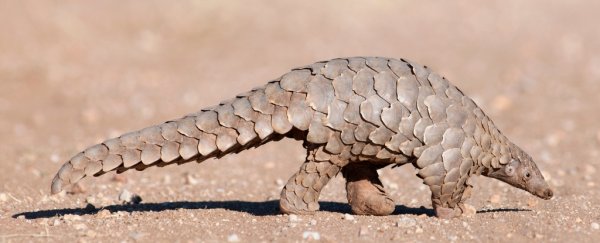Chinese researchers investigating the animal origin of the deadly coronavirus outbreak in China said Friday the endangered pangolin may be the "missing link" between bats and humans, but other scientists said the search may not be over.
An earlier study - since discredited - pointed to snakes, and there remain numerous candidate species in the Wuhan wildlife market thought to be ground zero of the epidemic.
The SARS outbreak of 2002-3, involving a different strain of coronavirus, was transferred to humans by the civet, a small mammal prized in China for its flesh.
Missing link: a pangolin?
Many animals are capable of transmitting viruses to other species, and nearly all strains of the coronavirus contagious to humans originated in wildlife.
Bats are known carriers of the latest strain of the disease, which has infected at least 31,000 people and killed more than 630 worldwide, mostly in China where the outbreak originated.
A recent genetic analysis showed that the strain of the virus currently spreading among humans was 96 percent identical to that found in bats.
But according to Arnaud Fontanet, from France's Pasteur Institute, the disease likely didn't jump straight from bats to humans.
"We think there's another animal that's an intermediary," he told AFP.
Several studies have shown that the bat-bourne virus lacks the necessary hardware to latch on to human cell receptors. But it's still not clear which animal is the missing link.
Fontanet believes the intermediary was "probably a mammal," possible belonging to the badger family.
After testing more than 1,000 samples from wild animals, scientists at the South China Agricultural University found the genome sequences of viruses in pangolins to be 99 percent identical to those on coronavirus patients, the official Xinhua news agency reported.
But other experts urged caution.
"This is not scientific evidence," said James Wood, head of the department of veterinary medicine at the University of Cambridge. "Investigations into animal reservoirs are extremely important, but results must be then be published for international scrutiny."
"Simply reporting detection of viral RNA with sequence similarity of 99+ percent is not sufficient," he added.
Wild goose chase?
To conclusively identify the culprit, researchers would need to test each species that was on sale at the market - a near impossibility given that it's now permanently closed.
Martine Peeters, a virologist at France's Institute for Research and Development (IRD), worked on the team that identified the host animal of the Ebola virus during recent epidemics.
They found that it was indeed a bat that passed the virus on to humans, and Peeters believes that's likely to be the case this time around.
During her Ebola research, "we collected thousands of bat droppings from several sites in Africa," Peeters told AFP.
Fontanet said that Chinese researchers were doing likewise now.
"They say they've analysed samples from a rubbish truck," he said. "They don't say which, but I think it's likely to have been excrement that was just lying around."
Why does it matter?
While it may be too late for this outbreak, identifying the carrier animal for the novel coronavirus could prove vital in preventing future flare ups.
China for example outlawed the sale of civet for food in the wake of the SARS epidemic.
Eric Leroy, a virologist and vet at the IRD said the search could well turn up a result quickly like in the case of SARS. Equally, it could take years.
"With Ebola, research started in 1976 and we didn't see the first results published until 2005," he told AFP.
One determining factor could be what percentage of the same species are infected.
"If that's low, less than one percent for example, that's obviously going to lower the chance you stumble upon an infected animal," said Leroy.
Prevent future outbreaks?
For Fontanet, coronavirus is just the latest example of the potentially disastrous consequence of humans consuming virus-carrying wild animals.
He said that China needed to "take pretty radical measures against the sale of wild animals in markets."
Beijing has prohibited the practice, but only moved to do so last month, when the outbreak was already out of control.
"Each time, we try to put out the fire, and once it's out we await the next one," said Francois Renaud, a researcher at the Paris-based National Centre for Scientific Research.
He recommended compiling a watch list of all animals that could potentially transmit viruses to humans.
"You need to see epidemics before they come, and therefore you need to be proactive," he said.
